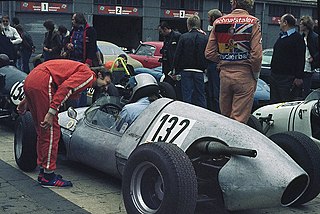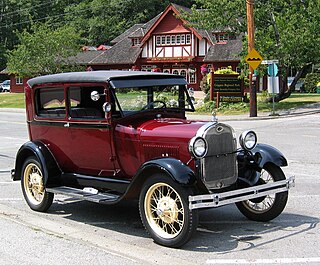
The Ford Model T is an automobile produced by Ford Motor Company from October 1, 1908, to May 26, 1927. It is generally regarded as the first affordable automobile, the car that opened travel to the common middle-class American; some of this was because of Ford's efficient fabrication, including assembly line production instead of individual hand crafting.

Cosworth is a British automotive engineering company founded in London in 1958, specialising in high-performance internal combustion engines, powertrain, and electronics; for automobile racing (motorsport) and mainstream automotive industries. Cosworth is based in Northampton, England, with American facilities in Indianapolis, Shelby Charter Township, Michigan and Mooresville, North Carolina.

A V4 engine is a four-cylinder engine with its cylinders arranged in a "V" configuration.

A flat-twin engine is a two-cylinder internal combustion engine with the cylinders on opposite sides of the crankshaft. The most common type of flat-twin engine is the boxer-twin engine, where both cylinders move inwards and outwards at the same time.

The straight-eight engine or inline-eight engine is an eight-cylinder internal combustion engine with all eight cylinders mounted in a straight line along the crankcase. The type has been produced in side-valve, IOE, overhead-valve, sleeve-valve, and overhead-cam configurations.

The straight-six engine or inline-six engine is an internal combustion engine with the cylinders mounted in a straight line along the crankcase with all the pistons driving a common crankshaft.
The straight-five engine or inline-five engine is an internal combustion engine with five cylinders aligned in one row or plane, sharing a single engine block and crankcase. The justification for a five cylinder engine is that it is almost as compact as an inline-four, and almost as smooth as a straight-six engine.
The tax horsepower or taxable horsepower was an early system by which taxation rates for automobiles were reckoned in some European countries such as Britain, Belgium, Germany, France and Italy; some US states like Illinois charged license plate purchase and renewal fees for passenger automobiles based on taxable horsepower. The tax horsepower rating was computed not from actual engine power but by a mathematical formula based on cylinder dimensions. At the beginning of the twentieth century, tax power was reasonably close to real power; as the internal combustion engine developed, real power became larger than nominal taxable power by a factor of ten or more.

A straight-three engine, also known as an inline-triple, or inline-three, is a reciprocating piston internal combustion engine with three cylinders arranged in a straight line or plane, side by side.

The Ford Köln is an automobile that was produced by Ford Germany from 1933 until 1936 at its Cologne plant.

The Ford Eifel is a car manufactured by Ford Germany between 1935 and 1940. It initially complemented and then replaced the Ford Köln. It was itself replaced by the Ford Taunus.
Economy car is a term mostly used in the United States for cars designed for low-cost purchase and operation. Typical economy cars are small, lightweight, and inexpensive to buy. Economy car designers are forced by stringent design constraints to be inventive. Many innovations in automobile design were originally developed for economy cars, such as the Ford Model T and the Austin Mini. The alternative approach, other than innovating to build a low-cost car, is to build a stripped-down, no-frills version of a conventional car.

The Ford Small Block is a series of automobile V8 engines built by the Ford Motor Company beginning in July 1961. The engine was discontinued in new trucks (F-Series) after 1996, and new SUVs (Explorer) after 2001, but remains available for purchase from Ford Racing and Performance Parts as a crate engine. The "Windsor" designation is an enthusiast designation applied for the family of engines sharing a common basic engine block design. The Windsor designation was adopted to distinguish the 351 cu in (5.8 L) version from the Cleveland 335-family engine that had the same displacement, but a significantly different configuration. The designations of 'Windsor' and 'Cleveland' were derived from the locations of manufacture: Windsor, Ontario and Cleveland, Ohio.

The Ford Pinto engine was the unofficial but generic nickname for a four-cylinder internal combustion engine built by Ford Europe. In Ford sales literature, it was referred to as the EAO or OHC engine and because it was designed to the metric system, it was sometimes called the "metric engine". The internal Ford codename for the unit was the T88-series engine. European Ford service literature refers to it as the Taunus In-Line engine and the Lima In-Line (LL)

The Ford flathead V8 is a V8 engine of the valve-in-block type designed by the Ford Motor Company and built by Ford and various licensees. During the engine's first decade of production, when overhead-valve engines were rare, it was usually known simply as the Ford V‑8, and the first car model in which it was installed, the Model 18, was often called simply the "Ford V‑8", after its new engine. Although the V8 configuration was not new when the Ford V8 was introduced in 1932, the latter was a market first in the respect that it made an 8-cylinder affordable and a V engine affordable to the emerging mass market consumer for the first time. It was the first independently designed and built V8 engine produced by Ford for mass production, and it ranks as one of the company's most important developments. A fascination with ever-more-powerful engines was perhaps the most salient aspect of the American car and truck market for a half century, from 1923 until 1973. The engine was intended to be used for big passenger cars and trucks; it was installed in such until 1953, making the engine's 21-year production run for the U.S. consumer market longer than the 19-year run of the Ford Model T engine for that market. The engine was on Ward's list of the 10 best engines of the 20th century. It was a staple of hot rodders in the 1950s, and it remains famous in the classic car hobbies even today, despite the huge variety of other popular V8s that followed.

Formula Junior is an open wheel formula racing class first adopted in October 1958 by the CSI. The class was intended to provide an entry level class where drivers could use inexpensive mechanical components from ordinary automobiles. The idea to form the new class came from Count Giovanni "Johnny" Lurani who saw the need of a class for single-seater racing cars where younger drivers could take their first steps. It is often speculated that this class was founded as a reaction to Italy's lack of success in the 500cc Formula Three, and although Italian marques dominated the first year of the formula, they were soon overtaken by British constructors.
The Lincoln Y-block V8 engine was Ford's earliest OHV V8 engine, introduced by Lincoln in the 1952 model year. Like the later and better-known but even more short-lived Ford Y-block engine, its block's deep skirts gave the block the appearance of the letter Y from the front.

Excelsior, based in Coventry, was a British bicycle, motorcycle and car maker. They were Britain’s first motorcycle manufacturer, starting production of their own ‘motor-bicycle’ in 1896. Initially they had premises at Lower Ford Street, Coventry, and 287-295 Stoney Stanton Road, Hillfields, Coventry, Warwickshire before moving to Kings Road, Tyseley, Birmingham in 1921.

The Ford Model A was the Ford Motor Company's second market success after its predecessor, the Model T. First produced on October 20, 1927, but not introduced until December 2, it replaced the venerable Model T, which had been produced for 18 years. This new Model A was designated a 1928 model and was available in four standard colors.

A V8 engine is an eight-cylinder V configuration engine with the cylinders mounted on the crankcase in two sets of four, with all eight pistons driving a common crankshaft. Most banks are set at a right angle (90°) to each other, some at a narrower angle, with 45°, 60°, and 72° most common.



















